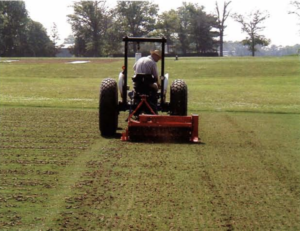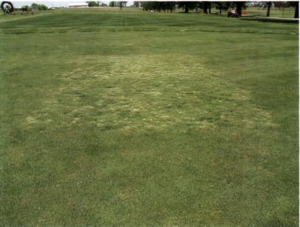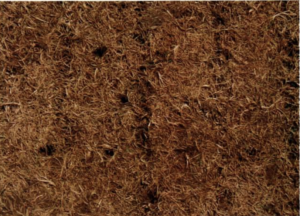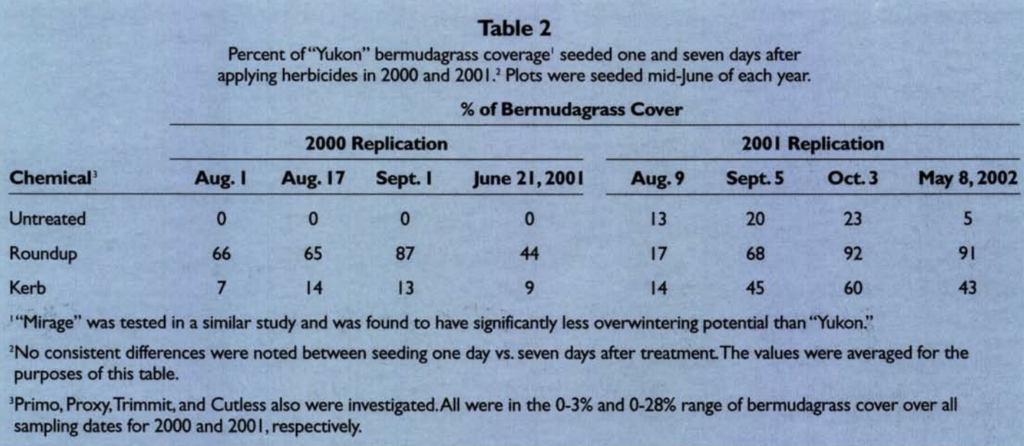Effective renovation to seeded bermudagrass.
BY D. W. WILLIAMS AND P. B. BURRUS
Perennial ryegrass (Lolium perenne) is a popular choice for golf course fairways in the transition zone. There are many perennial ryegrass cultivars that exhibit excellent turf quality: dark green color, high shoot density, acceptable heat and drought tolerance, and adaption to low mowing heights.
Disease resistance is another story, and fungal diseases may cause major problems. Perennial ryegrass is highly susceptible to brown patch (Rhizoctonia solani), pythium (Pythium spp.), and gray leaf spot (Pyricularia grisea). Each of these diseases can cause significant damage to perennial ryegrass fairways and may require regular fungicide treatments.
Bermudagrass (Cynodon dactylon) is also a desirable species for low-maintenance fairways in the transition zone due to its relative lack of pest problems, and it is at the peak of its growth during the peak of the golf season. It also allows cost-efficient and effective weed control strategies during its winter dormancy.
Much progress has been made in improving turf quality and cold-temperature hardiness of seeded bermudagrass, and using seeded bermudagrass has become a viable option for transition zone turf managers who wish to renovate perennial ryegrass fairways. However, the best methods of renovating existing perennial ryegrass fairways with seeded bermudagrass have not been investigated.
Turf renovation often requires herbicide applications to reduce or remove competition, thereby allowing new seedlings to become established. Glyphosate (Roundup) is often used in renovation and is very desirable for two reasons. The effects of glyphosate generally are not visible until five to seven days after application, allowing time for overseeded seed to germinate before the effects of glyphosate become apparent. Secondly, glyphosate applications have little effect on germination or establishment, even when seeded soon after application.


Pronamide (Kerb) is often used to selectively remove perennial rye grass from existing stands of bermudagrass following winter overseeding. However, pronamide is known to persist in soils for long periods of time and may have detrimental effects on seedling bermudagrass. As with glyphosate, however, the effects of pronamide on perennial ryegrass are not immediately visible, and this could allow bermudagrass germination and establishment before perennial ryegrass color and playability become unacceptable.
Several plant growth regulators are known to have activity on perennial ryegrass. Application of these products may reduce competition from perennial ryegrass during bermudagrass germination and establishment. It is important to test a range of plant growth regulators, as they have different modes of action and sites of entry into plant tissues.
FIELD EXPERIMENTS
This research project was designed to test chemical treatments to enhance establishment of seeded bermudagrass in existing perennial ryegrass fairway turf. The timing of seeding for successful renovation following chemical treatments also was evaluated. Experiments were conducted at the University of Kentucky’s Agricultural Experiment Station in Lexington.
Existing stands of mature perennial ryegrass maintained at % inch were used. Cultivars of seeded bermudagrass included “Mirage” and “Yukon.” Chemical treatments and plant growth regulators were applied at label rates along with an untreated control (Table 1).
Seeding was accomplished by aeration, vertical mowing, application of chemicals, and broadcasting seed by hand. Plots were then dragged with a steel mat. Timing treatments consisted of seeding one day or seven days following applications of chemical treatments. The seeding rate was 0.50 pounds of pure live seed per 1,000 square feet. Nitrogen was applied as urea at a rate of 1 pound N per 1,000 square feet once at seeding and once every two weeks following seeding until August 15 each year.


Bermudagrass establishment was evaluated weekly following treatments. Plots were rated for percent bermudagrass cover until the end of each growing season. Bermudagrass survival within each treatment combination was also rated during the following spring of each year.
In both years of the study, Roundup was the most successful treatment in renovating perennial ryegrass to seeded bermudagrass. Plots treated with Kerb resulted in significantly more bermudagrass cover than the untreated control and all plant growth regulator treatments in 2001.
However, the percent bermudagrass cover in Kerb-treated plots was significantly less than the cover recorded in Roundup plots. None of the plant growth regulator treatments were effective in enhancing bermudagrass cover more than the untreated. There were no consistent differences between seeding one day after chemical treatments vs. seven days after treatments. It also is very clear from the data that Yukon survived the winter following renovation significantly better than Mirage (Table 2).
The results of our research indicate that applications of Roundup provide a very acceptable transition of perennial rye grass fairways to seeded bermudagrass. However, plots treated with Roundup did not result in a smooth color transition. Kerb applied at label rates also resulted in significant bermudagrass establishment with a much smoother transition of color, but was not as successful in total renovation as Roundup-treated plots. Roundup plots were totally (100%) necrotic before bermudagrass germination.
Significant bermudagrass coverage (20-40%) was noted in 20-25 days following applications of Roundup in both years of the study, with 58-88% bermudagrass coverage by mid-August. Turf managers can expect successful renovation using Roundup, but they should also expect a significant reduction in turf quality (mainly color) for up to 60 days following application.

